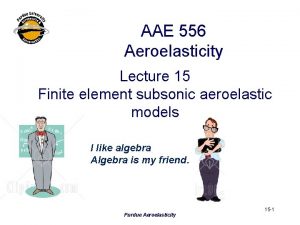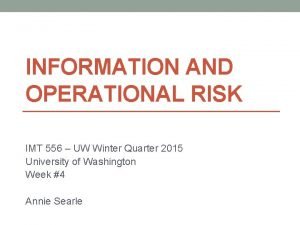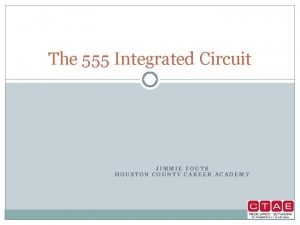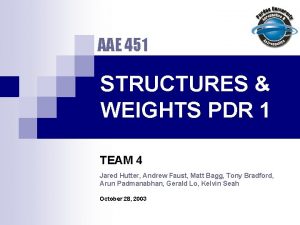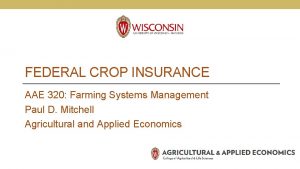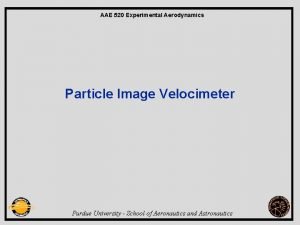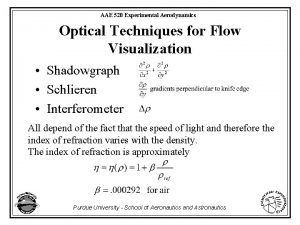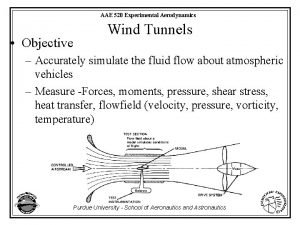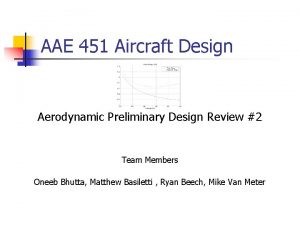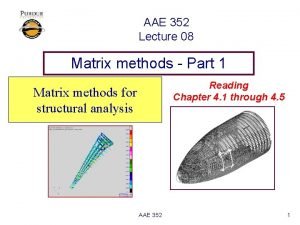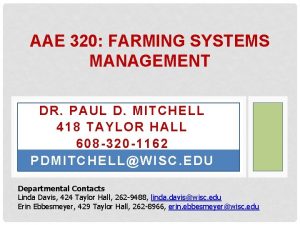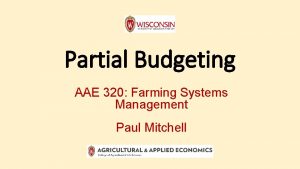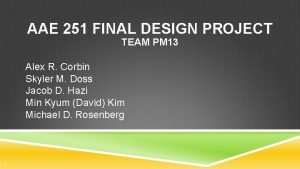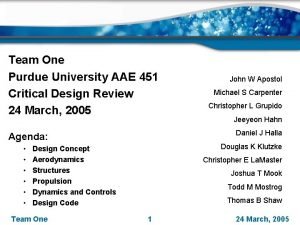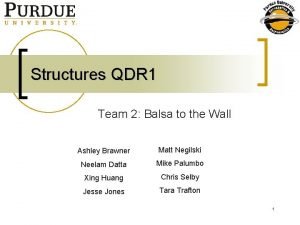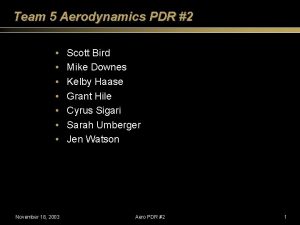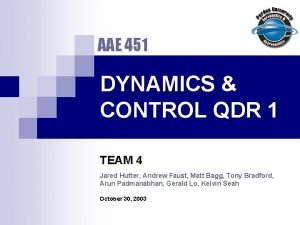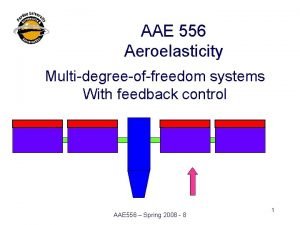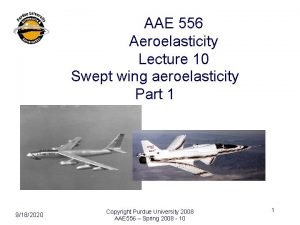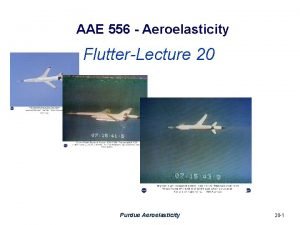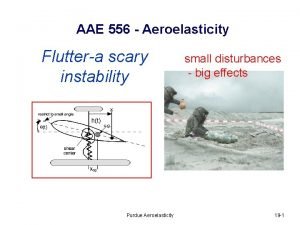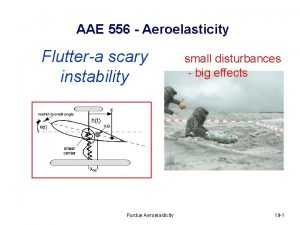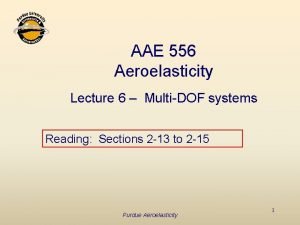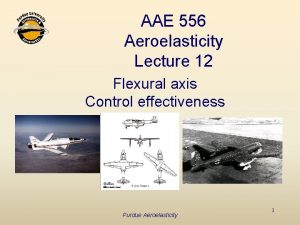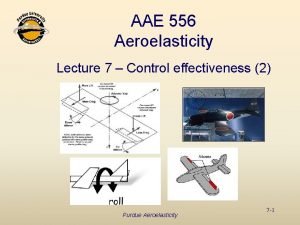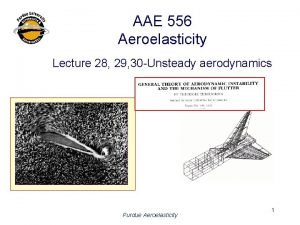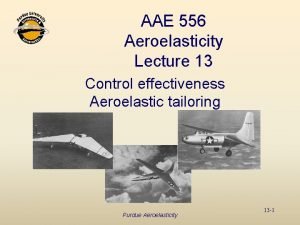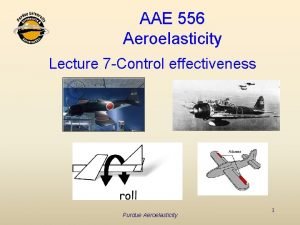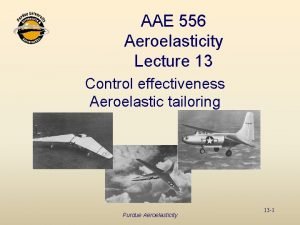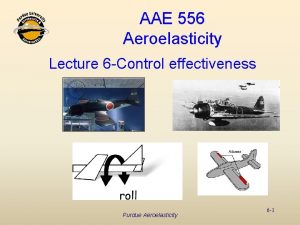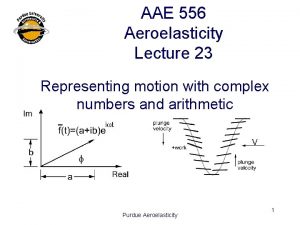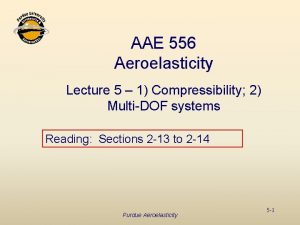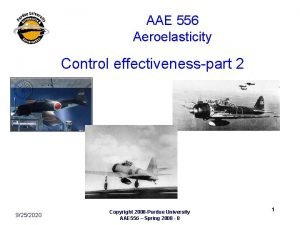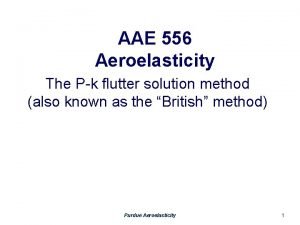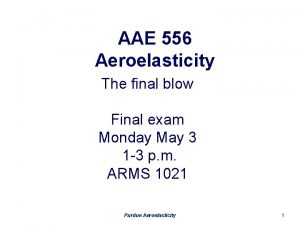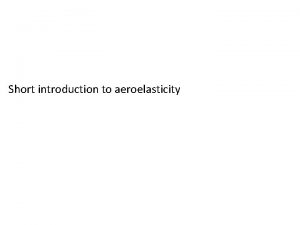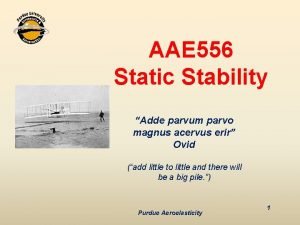AAE 556 Aeroelasticity Lecture 6 Multidegreeoffreedom systems AAE

























- Slides: 25

AAE 556 Aeroelasticity Lecture 6 Multi-degree-of-freedom systems AAE 556 – Spring 2008 - 6 1

Nonlinear models and finding the effects of aerodynamic stall on stability i i i Math model is at zero angle of attack when a non-aero load P is applied as shown Lift is a nonlinear (cubic function of angle of attack) Structural stiffness reponse is linear Pd is an applied moment AAE 556 – Spring 2008 - 6 2

Sum the moments about the shear center (the model pin) Define “Effective torsional stiffness” So - AAE 556 – Spring 2008 - 6 3

Plot effective stiffness for 4 values of q bar AAE 556 – Spring 2008 - 6 4

Also nondimensionalize the original static equilibrium equation by dividing by KT AAE 556 – Spring 2008 - 6 5

Plotting displacement angle q shows that multiple equilibrium states are possible above divergence q and the use of nonlinear analysis reveals what the angles are AAE 556 – Spring 2008 - 6 6

MDOF system study goals i Identify similarities and differences between 1 DOF and MDOF models i Define theoretical stability conditions for MDOF systems i Reading - Multi-degree-of-freedom systems – TAW text p. 63 -76 AAE 556 – Spring 2008 - 6 7

Develop a 2 DOF segmented aeroelastic finite wing model that represents it as two discrete aerodynamic surfaces with flexible connections fuselage Torsional springs wing root wing tip Torsional degrees of freedom AAE 556 – Spring 2008 - 6 8

Introduce “strip theory” aerodynamic modeling to represent twist dependent airloads i Strip theory assumes that lift depends only on local angle of attack of the strip of aero surface – why is this an assumption? Notice that q twist angles are measured from a common point AAE 556 – Spring 2008 - 6 9

The two twist angles are unknowns and we have to construct two free body diagrams Structural restoring torques depend on the difference between elastic twist angles Wing root Wing tip Double arrow vectors are torques Internal shear forces are present, but not drawn AAE 556 – Spring 2008 - 6 10

Torsional static equilibrium is a special case of dynamic equilibrium Arrange these two simultaneous equations in matrix form AAE 556 – Spring 2008 - 6 11

Summary i Static equilibrium equations are necessary to solve aeroelastic problems i Solution in terms of unknown displacements and known applied loads i Matrix equation order, sign convention and listed ordering of unknowns is important AAE 556 – Spring 2008 - 6 12

Problem solution Both equations on the left hand side multiply the same vector The aeroelastic stiffness matrix is Solve for q 1 and q 2 AAE 556 – Spring 2008 - 6 13

The solution for the q’s requires inverting the aeroelastic stiffness matrix AAE 556 – Spring 2008 - 6 14

The aeroelastic stiffness matrix determinant is a function of q i The determinant is where When dynamic pressure increases, the determinant D tends to zero – what happens to the system then? AAE 556 – Spring 2008 - 6 15

Solve for the twist angles created by an initial system input angle of attack ao AAE 556 – Spring 2008 - 6 16

determinant Plot the aeroelastic stiffness determinant D against dynamic pressure (parameter) Where do the original assumptions about small angles break down? Dynamic pressure parameter The determinant of the stiffness matrix is always positive before the air is turned on AAE 556 – Spring 2008 - 6 17

divergence panel twist, qi/ao Twist deformation vs. dynamic pressure parameter Unstable q region Outboard panel (2) determinant D is zero AAE 556 – Spring 2008 - 6 18

Panel lift computation on each segment gives: Note that AAE 556 – Spring 2008 - 6 19

More algebra - Flexible system lift Set the lift equal to half the airplane weight AAE 556 – Spring 2008 - 6 20

Lift re-distribution due to aeroelasticity Observation - Outer wing panel carries more of the total load than the inner panel as q increases AAE 556 – Spring 2008 - 6 21

Question – How do we determine divergence for an MDOF system? The general form of the aeroelastic static equilibrium equations is n degrees of freedom Perturb the system by an amount Euler question – “Is there an equilibrium solution to the following relationship? ” AAE 556 – Spring 2008 - 6 22

Static stability The static stability test reduces to the existence of a homogeneous matrix equation that must hold if the system is neutrally stable ? AAE 556 – Spring 2008 - 6 23

Linear algebra says. . . only if … or This is an nth order determinant sometimes called the stability determinant AAE 556 – Spring 2008 - 6 24

Summary i System is stable if the aeroelastic stiffness matrix determinant is positive. – When additional loads are applied, the system can absorb energy and go to a unique static deformation mode. i If the stability determinant is negative then the static system, when perturbed, cannot absorb all of the energy due to work done by aeroelastic forces - it must become dynamic and will move, looking for a new equilibrium state. AAE 556 – Spring 2008 - 6 25
 Purdue aae 590
Purdue aae 590 National weather service forecast
National weather service forecast 866-556-8166
866-556-8166 Imt 556
Imt 556 556 pwm circuit
556 pwm circuit 01:640:244 lecture notes - lecture 15: plat, idah, farad
01:640:244 lecture notes - lecture 15: plat, idah, farad Aae 508 purdue
Aae 508 purdue Aae 320
Aae 320 Aae 520
Aae 520 Aae 520
Aae 520 Aae 520
Aae 520 Aae design
Aae design Aae 352
Aae 352 Aae 320
Aae 320 Aae 320
Aae 320 Aae 251 purdue
Aae 251 purdue Aae 451
Aae 451 Aae glass tutorial
Aae glass tutorial Aae 421
Aae 421 Aae 421
Aae 421 Operating systems lecture notes
Operating systems lecture notes Articulators
Articulators Lecture sound systems
Lecture sound systems Decision support systems and intelligent systems
Decision support systems and intelligent systems Principles of complex systems for systems engineering
Principles of complex systems for systems engineering Embedded systems vs cyber physical systems
Embedded systems vs cyber physical systems
